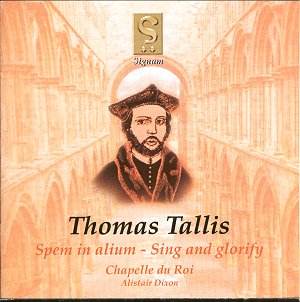For such a large-scale work, 'Spem in Alium'
seems to have left remarkably little trace in history. We do not
know when (or why) Tallis wrote it nor do we have any documentary
record of its first performance. So over the years a tradition
built up of large-scale performance, typefied by David Willcocks’
1965 recording sung by King's College Choir and Cambridge University
Musical Society. A sea change happened with the recording by the
Clerkes of Oxenford under David Wulstan. Here the motet was sung
at a higher pitch, with one person to a part in a performance
notable for its transparency and beauteous clarity of line. Listening
to this recording, I was struck again by the striking difference
between it and most other recordings. Not everyone will like the
sound-world that Wulstan conjures up, but one cannot help but
admire the wonderful control of his high (very high) sopranos.
And the recording transformed the way we think of the piece.
We have also been learning
to alter our perceptions of why, and
how the piece came to be written. It
has long been assumed that the work
was written in 1573 for the 40th
birthday of Queen Elizabeth I, hence
the 40-part nature of the piece. Peter
Philips has speculated, in an interview,
that Tallis might not even have heard
the work in full. But, though the documentary
record is sparse, the work must have
made some impression on Tallis's contemporaries
at the Chapel Royal. For, in 1610, when
preparations were underway for the coronation
of Prince Henry (eldest son of King
James I) as Prince of Wales, 'Spem in
Alium' was dusted off in a version with
new English words. After Prince Henry's
death, the coronation went ahead with
Prince Charles (future King Charles
I) in his stead and 'Spem in Alium'
was performed in its new guise as 'Sing
and Glorify'.
And it is as 'Sing and Glorify' that the work
has come down to us. The earliest manuscript, the Egerton Manuscript,
uses the English words which are noticeably more cheerful than
the Latin ones. The performance at Prince Charles's coronation
is notable for other reasons as well. A contemporary diarist,
in 1611, remembered how the piece had first been commissioned
by Thomas Howard, 4th Duke of Norfolk as an answer
to Striggio's 40 part 'Ecce beatam lucem' and the work was first
performed in the long gallery at Arundel House in the Strand.
If this memory is accurate, then we may presume
that the private performance may well have involved the Chapel
Royal and other members of the musical establishment. But given
the contemporary preference for performing the work in echoing
churches, the mind boggles at the idea of a performance in a private
house, albeit a large-ish one like Arundel House.
On this recording, the Chapelle du Roi under
Alistair Dixon give performances of both 'Spem in Alium' and its
contrafactum 'Sing and Glorify'. They perform the work with one
singer per part but recorded the works in the huge echoing spaces
of All Hallow's Church, Gospel Oak, London.
In live performance the choirs enter singly,
one by one. So the music is notable for the way the centre of
the music moves across the choir leading to some thrilling acoustic
effects and later on the climaxes can involve some brilliant antiphonal
effects. This can be difficult to bring off on a recording. The
recording by the Tallis Scholars under Peter Philips on Gimmell
is noticeable for the brilliance with which the recording engineers
have tackled this challenge. And the recording by Pro Cantione
Antique under Mark Brown is also successful in this way.
Unfortunately, the recording by the Chapelle
du Roi is less impressive in this respect. There are too many
moments when the choir comes over as a generally aural wash with
key personnel highlighted. The recording has an unfortunate tendency
to spotlight individuals so that some of the sopranos, in particular,
tend to stand out. The middle parts also blend into a single muddy
texture rather than a combination of individual lines. The climaxes
are certainly thrilling but recording in All Hallows, with the
resultant huge backwash of sound, was a mistake I think. The recording
sounds like a choir of 40 trying to sound like a bigger group.
What makes the recording special is the ability
to hear the English contrafactum alongside the original Latin.
In many places, of course, the English words disappear in the
general aural wash. But singing in English does certainly give
a different sound to the piece in some places.
This recording is quite an achievement. The pieces
were recorded as part of the Chappelle du Roi's complete Tallis
Edition and as such will be appearing in volumes 7 and 8. Surrounded
by their sophisticated performances of Tallis's other works, I
think that these recordings could be quite valuable. But here,
issued as a short CD with just the two works, the performances
have their shortcomings highlighted.
Quite how you want 'Spem in alium' to sound is
a very personal matter and many people will already have a favourite
recording. But this one is worth considering for its inclusion
of 'Sing and Glorify'.
Robert Hugill

